PORT LINCOLN OFFSHORE
Recently Jordan Saliba was lucky enough to spend eight days in the fishing capital of SA, Port Lincoln. Quite obviously, he enjoyed quite a special holiday in this wonderful location.
Port Lincoln is home to some of the most unique and thrilling fishing experiences, whether from land or kilometres offshore. In the warmer months its famous tuna run begins, along with some other big game fish that arrive, so this year I had to get my own slice of the pie! Before I run you through how my offshore trip went, it’s important to know what type of gear you’ll need and the tips and tricks that will help you get your own mixed bag of treats.
BOAT SET-UP AND SAFETY TIPS
When heading offshore, having the right equipment and safety precautions in place is simply non-negotiable. A well-equipped boat will ensure clear navigation, efficient fishing and, most importantly, that peace of mind in unpredictable offshore conditions.
But first things first; having a boat that is fit for rough seas is essential. Vessels with a deep-Vhull design are ideal, as their ability to handle big swell and rough seas make it a lot safer and comfortable. Second to that is having a reliable motor, along with a back-up motor or secondary power source in case of a mechanical failure.
Equipping your boat with the right gear is also very important and can be the difference between a great experience and a horrible one. A high-quality GPS and fish finder are simply invaluable when going offshore, as most of the time you are exploring new territory. A VHF radio is also a requirement so you can communicate with other boats and emergency services, as phone reception can be unreliable offshore. Other pieces of equipment you may want to consider are a reliable anchor set-up, a bilge pump, an EPIRB and an offshore flare kit in case of an emergency.
To make the fishing a whole lot more enjoyable, having things like rod holders, live bait tank and ample storage for pre-made rigs and tackle is a great idea. Overall, just make sure you do your required research and don’t rush anything just for the sake of heading out. Like they say, there’s no fish that’s worth your life.
ESSENTIAL GEAR AND TACKLE FOR OFFSHORE
RODS
Selecting the right rod is something you do not want to take lightly when fishing extremely deep water for 15kg-plus fish. Offa boat, having a long rod can be quite challenging and awkward when needing to cast and when you get the fish up to the boat when landing. So, a 6-7ft rod which is rated around 15-24kg has been my go-to when fishing offshore. I find these rods still manage to cast well, but also provide great sensitivity and power to manage big fish.
REELS
For land-based fishing you can mostly get away with a cheaply priced, reel as it won’t cop a huge amount of salt water or pressure to the drag system. However, in my opinion I would highly recommend investing in a mid to high range reel which is built to handle a spray of salt water and has a reliable drag system.
A 6000 sized reel is great for 12-15kg fish, but if you are wanting to target some bigger models, I would recommend looking at something in the 10,000-18,000 range. You can also consider overhead reels if you are serious about your sport fish!
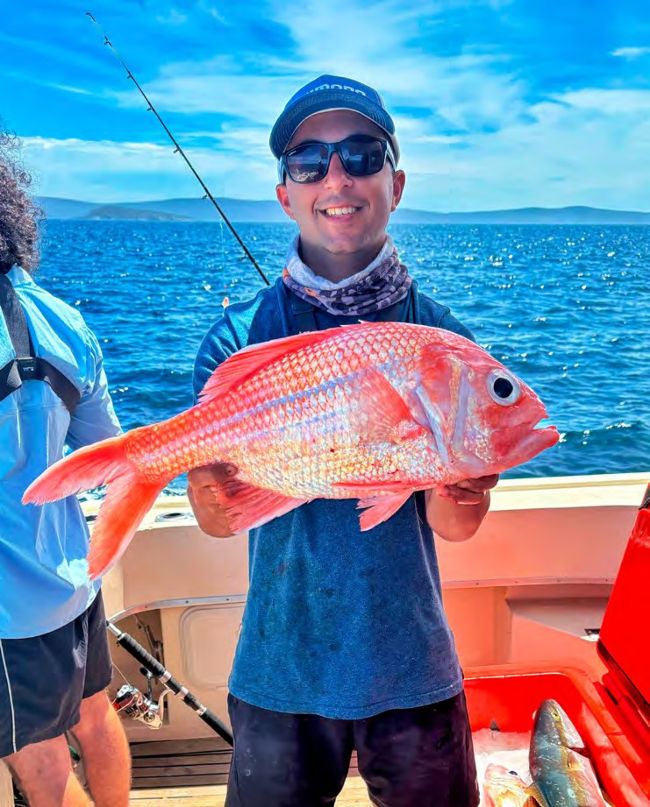
Big nannygai are easy to find on most reef systems
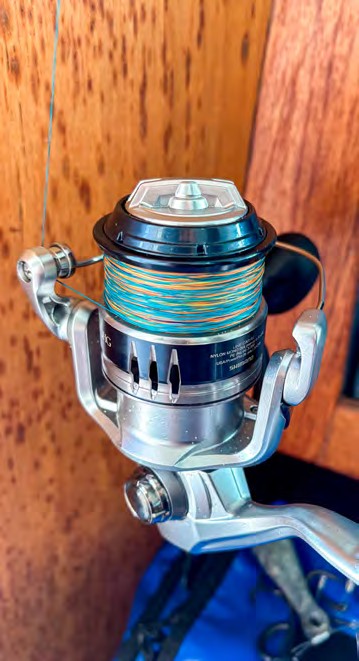
A 6000 size real is ideal
BRAID AND LEADER
When it comes to braid and leader, this is also something you need to consider carefully! The worst thing you could do as an angler is get that cheap line which could potentially let you down, resulting in losing that dream fish. For tuna and those bigger fish, anything from 60lb100lb braid will be your safe option. However, for smaller tuna, kingfish and other big reef species you can quite easily get away with PE 3 braid, which will be around 40-45lb. If you are targeting massive models, consider 80-100lb or even 130lb, but for those 5-15kg fish 50-80lb should be ample. I also can’t stress enough about learning how to tie an FG knot so you have that peace of mind when tightening your drag on those reef fish!
BAIT
Let’s start with the traditional method that has endured the test of time – bait fishing. When it comes to bait fishing, you can almost guarantee that if the fish are there, they will enjoy a free feed of that fresh fish or squid you caught upon anchoring.
In the case of offshore fishing, swallowtail, nannygai, squid and barracouta can be great baits and are easy to find. We had great success on a two-hook paternoster rig sending down some fresh swallowtail and squid. Live squid would have to be my favourite though, as nothing will swim past a tasty treat like that, not even us humans!
LURES
Fishing with lures offshore can be one of the most exciting and effective way to target anything from tuna to kingfish, nannygai, Samsons and much more!
For tuna the most famous and effective technique would be trolling lures, which is most anglers’ go-to method. The trolling method involves dragging a spread of lures behind your boat at varying speeds, typically between 6-10 knots. Skirted lures, deep-divers and hard body minnows are popular amongst most anglers for this method, as these mimic what the tuna mostly feed on. To utilise this method to its full potential, you must try and find ‘bust-ups’ or birds hitting the surface, which indicate the tuna feeding. An important tip would be to drive around the ball of fish but close enough, so your lures are in sight of the tuna. Driving right over the school can spook the fish and they might dive deep, resulting in a missed opportunity.
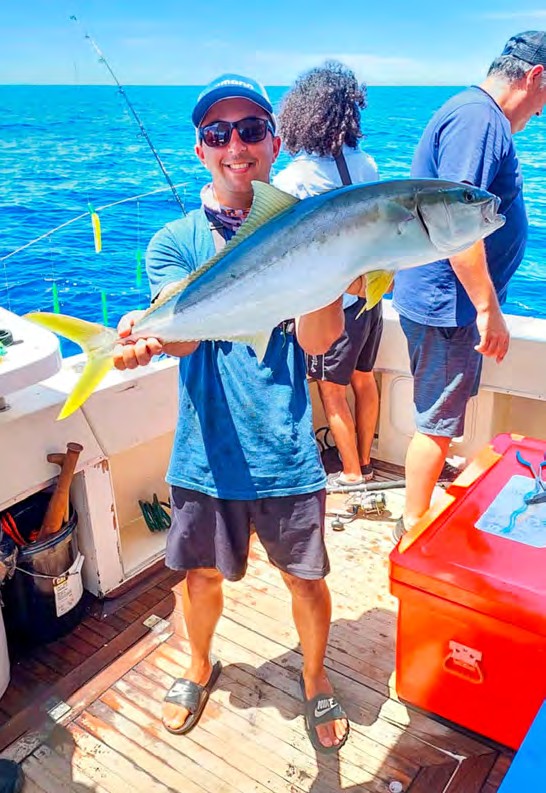
For your other varieties such as kingfish, nannygai and other reef species, using jigs or soft plastics can be a super effective method. Kingfish, especially, are highly aggressive predators that respond well to fast and erratic retrieves that trigger an explosive strike. Vertical jigging metals or plastics in deeper water is a proven method to catch these prized gamefish, and worked tremendously well for us on our trip.
To master this technique, you want to make sure you get your lure as far down to the bottom as possible, then you have two options. The first option is to give it two or three whips off the bottom and let it flutter back down. Using this method, you will find most of your hits will be on the way down when the lure is working its magic. The second option is aggressively jigging and retrieving line, imitating a fleeing baitfish, which can be ultra effective for kingfish in particular. If you don’t get any hits about half to three quarters of the way up, let the lure flutter back down to the bottom and start again.
TECHNIQUES – BAIT V LURES
There are so many ways to target these big fish offshore, whether that be from sending down a live bait, rigging up some freshly caught fish fillets or challenging yourself with lures and jigs.
LOCATIONS
Port Lincoln is renowned as one of Australia’s premier offshore fishing destinations, especially with its deep-water trophy fish. Whether you are after southern bluefin tuna, kingfish, nannygai and other reef species, these waters have all that and more!
NEPTUNE ISLANDS: THE BIG GAME FISHING HOTSPOT
The Neptune Islands, located about 60km south-west of Port Lincoln, are not only famous for great white sightings, but also their incredible fishing opportunities. These islands, surrounded by deep water, attract massive south bluefin tuna, which feed on the never-ending schools of baitfish. Some fish in this area can get huge, but most catches reported are around 10-40kg on average. Deep drop-offs and reefs around the islands can be a great place to target big kingfish, blue morwong, snapper and nannygai. If you have the right boat for it, the Neptune Islands will be an experience you will never forget!
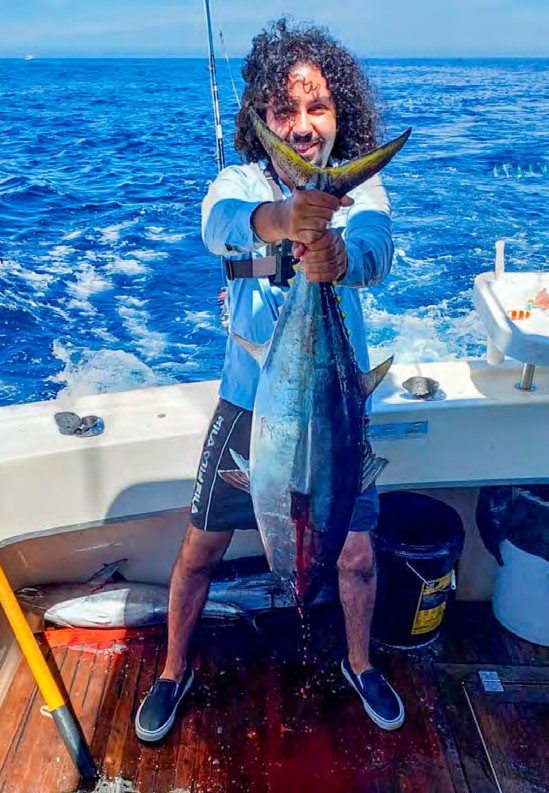
Bluefin and kings are the most popular targets
THORNY PASSAGE AND CABBAGE PATCH: KINGFISH TERRITORY
The Thorny Passage is a stretch of water between the mainland and offshore islands and is a great spot for targeting yellowtail kingfish. These fish are notorious for their stubborn attitude and fierce runs, giving your reel the ultimate stress test. The ‘Cabbage Patch Reef’ is a well-known hotspot where large kingfish are known to school up. You may also encounter a few Samson fish and snapper as bycatch. Please keep in mind what you can and can’t keep, snapper lovers!
BOSTON BAY AND THE REEFS BEYOND
If you’re looking for great fishing without having to head too far offshore, Boston Bay and its surrounding reefs provide plenty of fun. The inshore waters here are very productive for snapper, King George whiting and squid, as well as other fan favourites like nannygai and gummy sharks.
All in all, Port Lincoln’s offshore and even inshore fishing locations offer a diverse range of angling experiences, from high adrenaline game fishing to relaxing drifts for squid. If you’re reading this and haven’t booked that trip yet, it’s time to start looking at some dates!
MY EXPERIENCE TO THE NEPTUNE ISLANDS
Before my trip to Port Lincoln earlier this year I had only heard about the amazing fish that had been caught from these waters, so to say I was excited is an understatement. It all kicked off with the 4am start and a quick shot of coffee before we packed our gear into the cars and headed to the marina. It took just under two hours to reach the Neptune Islands, and I can confidently say it was the longest two hours of my life!
Once we finally arrived, we located some nice lumps on the sounder and used some squid to catch swallowtail, which were not hard to come by. We then used swallowtail for bait on our two-hook paternoster rigs and started to catch some nice nannygai in about 60-80m of water.
After we had filled up our eskies with a good feed of nannygai, it was time for the main event, southern bluefin. The chosen method on that day was trolling skirted lures, which apparently work well in these waters. It didn’t take long until we saw our first patch of tuna schooled up, so we carefully trolled our lures over the school and sure enough we had fish on. The initial run they give is a true adrenaline rush, and these fish are most famous for giving anglers a hard time getting their head above water, as they just don’t give up!
Once we landed our first fish, which would have been around 10-12kg, we did another troll and ended up enticing two more that got our bag to three. Unfortunately, we could not find any more tuna after this, so we used that time to store the fish and handle them with the best method possible.
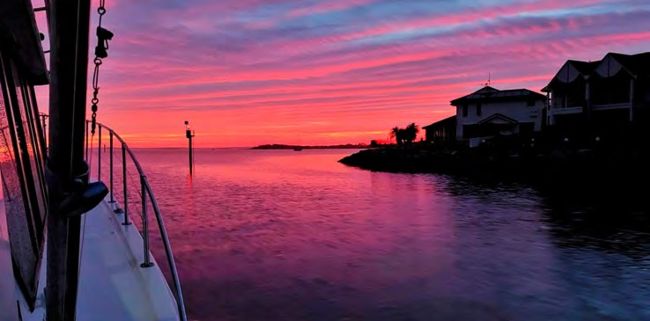
An early start at Lincoln Cove
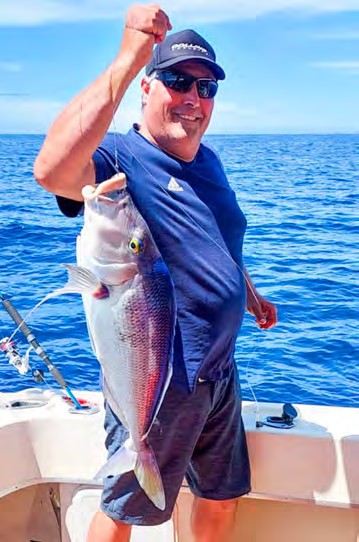
Blue morwong are always a bonus
At this stage of the day it was about 3pm, so we decided to head in a little closer and see what we could find on some reefs. On the first cast a piece of swallowtail got demolished by a solid 9-10kg kingfish and was shortly followed by a mammoth blue morwong! We then made the call to steam back in, as everyone was started to feel the effects of the early start!
This would be one of the most memorable fishing experiences I have had to date and for sure won’t be my last time in Port Lincoln!
In conclusion, Port Lincoln lived up to the hype, and I will find any excuse to head back there soon. If you are interested in my day out, you can head over to @JordanSAFishingon YouTube, where you can watch the day from start to finish! You can also find me on Instagram @JordanSAFishing,where I posted some land-based content while in Port Lincoln. Thanks for reading and until next time, tight lines!